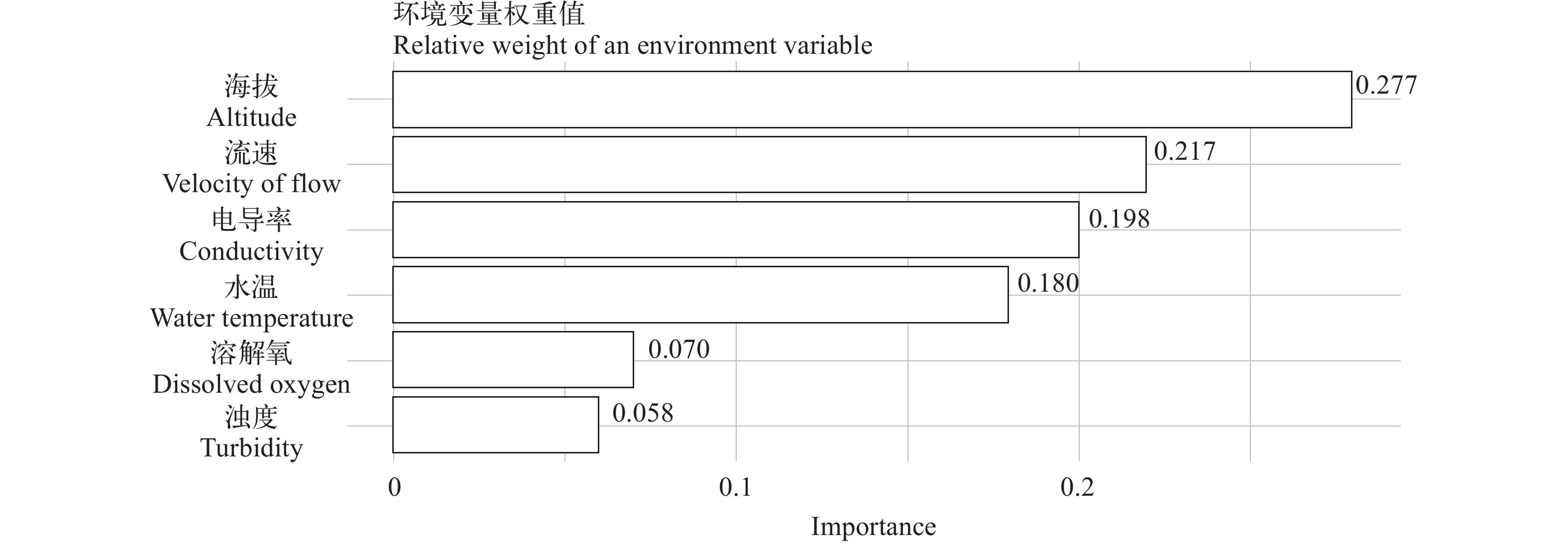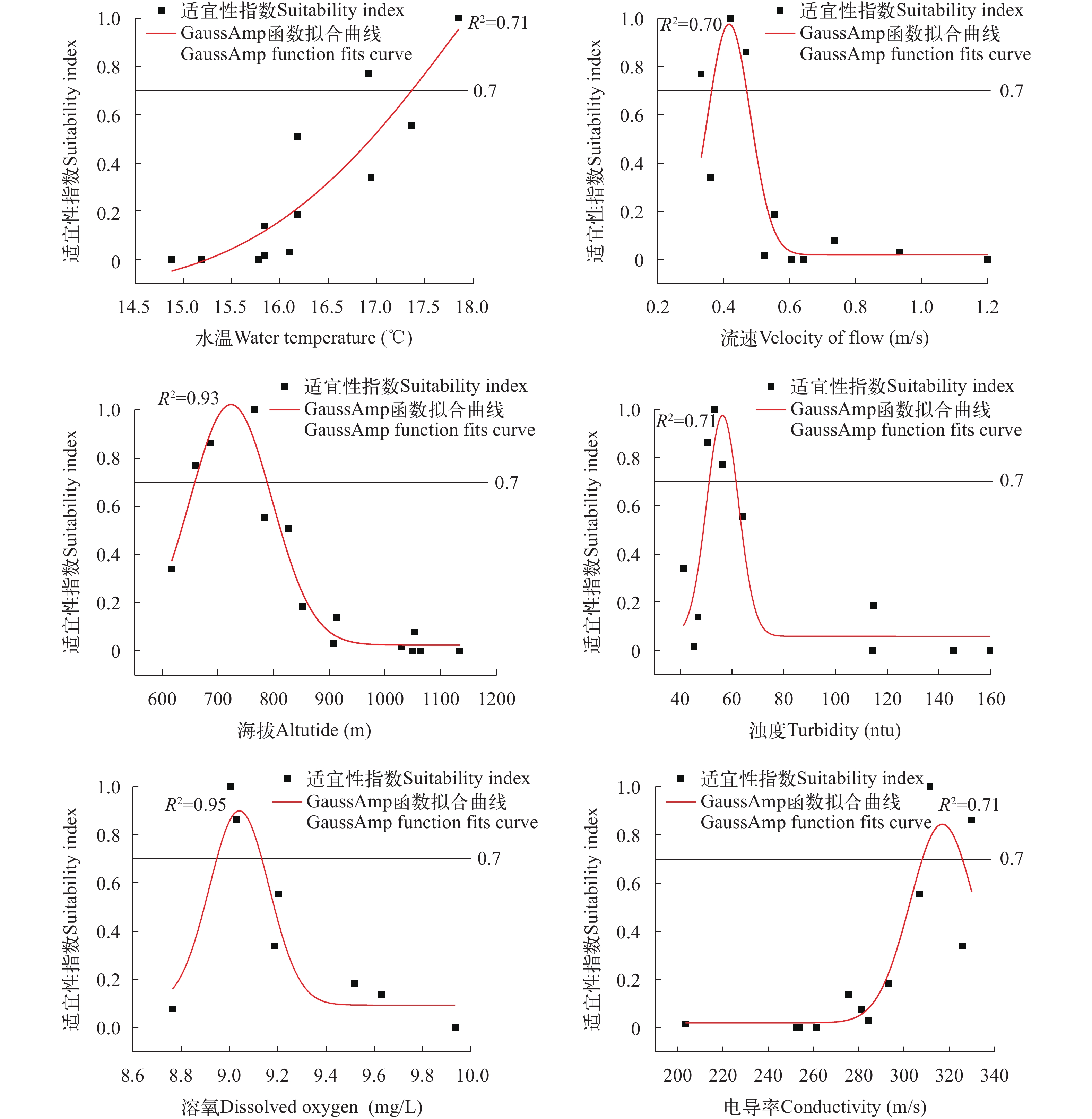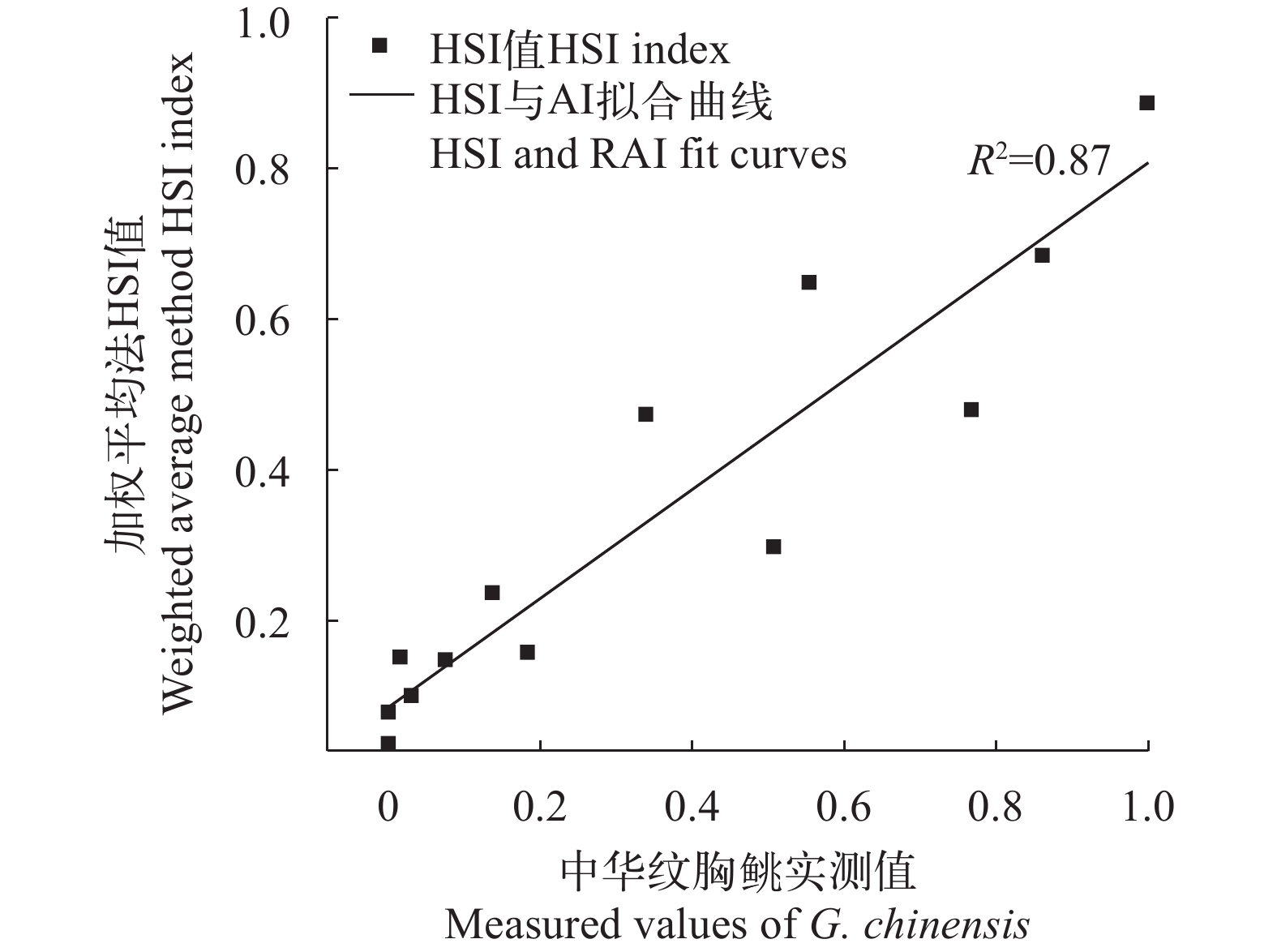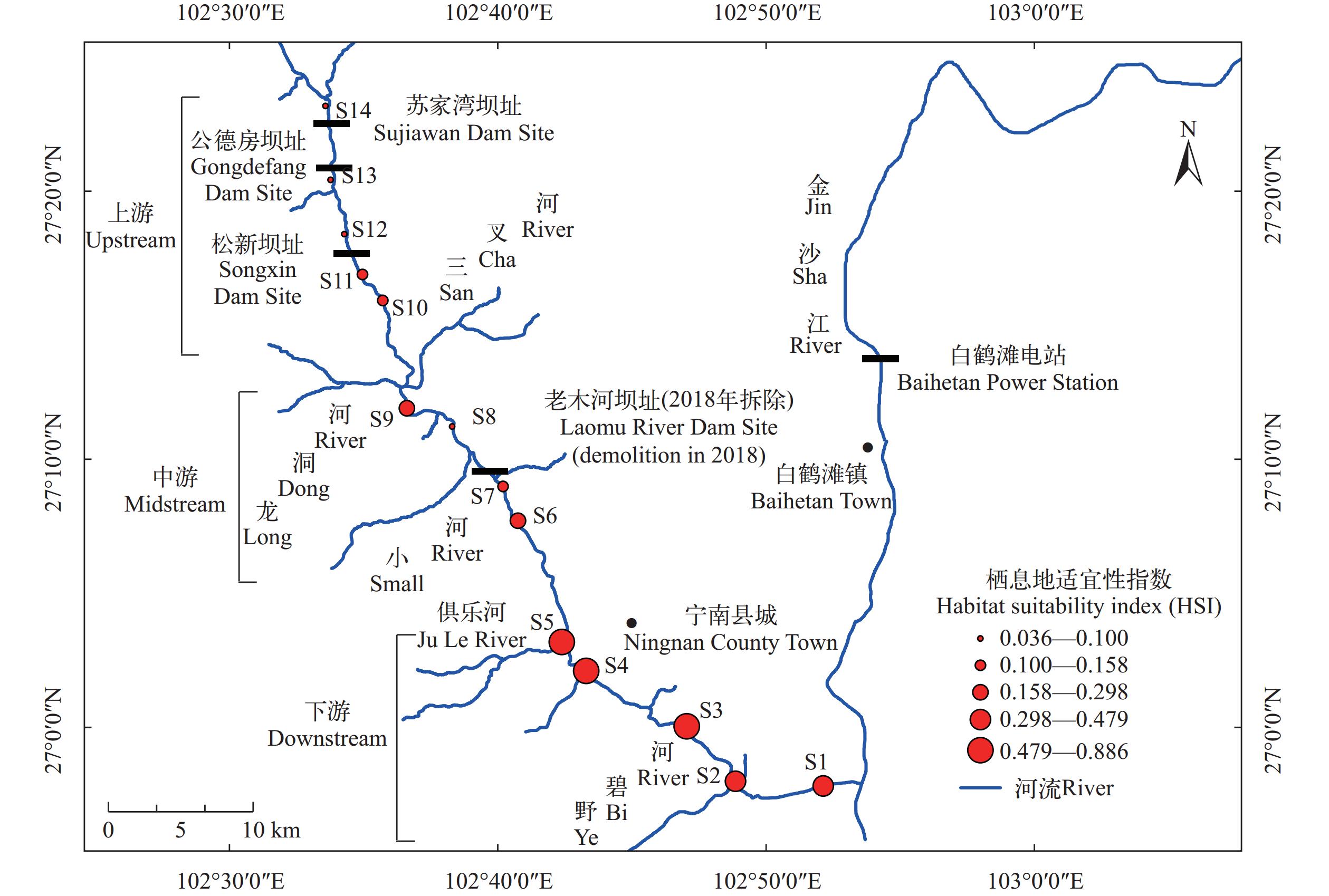ALGORITHM SCREENING AND EVALUATION OF HABITAT SUITABILITY INDEX FOR GLYPTOTHORAX SINENSE IN THE HEISHUI RIVER
-
摘要:
为研究中华纹胸鮡(Glyptothorax sinensis)栖息地适宜性指数(Habitat suitability index, HSI)模型最优算法, 科学评估其适宜栖息地分布, 基于2018—2019年黑水河中华纹胸鮡渔获物数据及同步采集的13个环境因子, 采用一元非线性函数拟合构建单个环境因子SI曲线, 并结合最大值法(Maximum, MAX)、最小值法(Minimum, MIN)、算术平均法(Arithmetic mean model, AMM)、几何平均法(Geometric mean model, GMM)、加权平均法(Weighted moving average, WMA)分别计算中华纹胸鮡HSI值。计算结果表明: 在各模型算法中, 算术平均法和加权平均法两种方法的预测结果误差最小, 最大值法与最小值法的预测结果与中华纹胸鮡实际分布偏差较大, 在进行算法选择时要慎重考虑。黑水河中华纹胸鮡栖息地适宜性指数总体呈现上游至下游纵向上升趋势, HSI值大于0.7的点位为下游自然河段S3和S4。水温、海拔等物理环境是驱动中华纹胸鮡栖息地空间分布差异的主要因素。算术平均法及加权平均法为黑水河中华纹胸鮡栖息地适宜性指数模型预测最优算法。研究结果可为黑水河鱼类栖息地评估提供参考资料, 促进鱼类栖息地保护。
Abstract:Habitat assessment is a prerequisite for in-situ conservation of fish, and appropriate model algorithms is an important basis for improving the prediction accuracy of habitat assessment models. This study aims to identify the optimal algorithm for the habitat suitability index (HSI) model of Glyptothorax sinensis and to scientifically evaluate its suitable habitat distribution. We utilized fishery catch data and 13 environmental factors collected synchronously from the Heishui River from 2018 to 2019. A one-dimensional nonlinear function was employed to fit a single environmental factor curve, and HSI values of G. sinensis were calculated using the maximum value method, minimum value method, arithmetic mean model, geometric mean model, and weighted moving average. The results indicate that among the various model algorithms, the arithmetic mean model and weighted moving average model exhibited the smallest prediction error, while the maximum and minimum value method showed significant prediction error and deviated notably from the actual distribution of G. sinensis. Therefore, caution should be taken when choosing model algorithms. Overall, the HSI index of G. sinensis in the Heishui River shows an upward trend from the upstream to the downstream, with sections S3 and S4 exhibiting HSI values greater than 0.7. Water temperature and elevation are the main driving factors for the spatial distribution differences in G. sinensis habitat. The arithmetic mean model and weighted moving average model are identified as the optimal algorithm for predicting the habitat suitability index of G. sinensis in the Heishui River. The research results can provide reference for the assessment of fish habitats in the Heishui River and promote the protection of fish habitats.
-
Keywords:
- Habitat suitability index /
- Optimal algorithm /
- Heishui River /
- Glyptothorax sinensis
-
长江上游由于复杂的生态环境, 拥有丰富的鱼类资源, 是我国鱼类多样性最为丰富的地区之一[1], 但近年来上游干流金沙江由于水坝修建、挖砂采石、岸坡硬化等人为因素影响[2—4], 鱼类栖息地受到了严重破坏。支流作为干流鱼类生物多样性来源的重要组成部分[5], 开展鱼类栖息地的保护和修复工作能在一定程度上缓解干流生态破坏所导致的生物多样性损失[6]。栖息地适宜性评估是开展栖息地保护与修复的重要前提[7], 评估的准确性则是提高栖息地适宜性评估可信度的重要保障。目前国外对于提高物种栖息地适宜性模型评估的准确性做了大量的研究。如Kuiper 等[8]通过使用机载激光扫描数据表征对鱼类栖息地重要的河流形态特征来提高适宜性模型评估的准确性。Crawford等[9]使用专家经验法来提高适宜性模型评估的准确性, Brownscombe等[10]通过筛选广义线性混合模型和随机森林等多种算法来提高栖息地预测模型的准确性。Northrup等[11]则通过回顾近20年来动物栖息地评估建模的概念和方法进展, 为从事相关研究的学者提供参考资料。目前国内对于提高鱼类栖息地适宜性模型评估准确性和鱼类栖息地保护的相关研究主要集中在海洋物种和保护物种[12—16], 长江上游支流鱼类栖息地适宜性模型评估研究相对较少。因此目前亟需对长江上游重要支流鱼类物种开展栖息地适宜性评估模型研究, 为长江上游鱼类多样性保护与修复提供参考资料。栖息地适宜性指数 (Habitat suitability index, HSI)模型能够对影响鱼类栖息地适宜性的关键环境变量进行量化分析[17, 18], 从而评估研究对象的适宜栖息地分布。由于该模型会因模型算法不同而导致不同的评估结果, 因此是研究鱼类栖息地适宜性模型评估准确度的良好工具。
黑水河为金沙江左岸一级支流, 由于金沙江下游干流梯级电站建设与运行造成原有生境改变[19], 目前已被作为金沙江下游鱼类主要的替代生境河流, 在长江上游鱼类保护中具有重要的价值。中华纹胸鮡(Glyptothorax sinensis)隶属于鲇形目(Siluriformes)鮡科(Sisoridae)纹胸鮡属(Glyptothorax) , 别称石黄姑、石爬子, 为中国特有物种[20, 21]。该鱼栖息在流水生境及水体底部, 产黏性卵[21], 对河流开发和环境改变极为敏感[22, 23]。作为黑水河的优势物种和主要的经济物种之一, 中华纹胸鮡的栖息地适宜性研究能够间接反映黑水河其他鱼类物种生存的现状[23]。
鉴于此, 本研究基于2018—2019年黑水河渔获物及相关环境因子数据, 拟对黑水河中华纹胸鮡的栖息地适宜性进行评估。通过比较最大值法、最小值法、算术平均法、几何平均法、加权平均法五种HSI模型算法[24—26]的预测差异, 筛选出黑水河中华纹胸鮡HSI模型最优算法, 确定黑水河中华纹胸鮡栖息地适宜性指数。揭示黑水河中华纹胸鮡栖息地分布规律, 为后续黑水河鱼类栖息地适宜性评估及山溪河流鱼类栖息地修复指导提供参考资料。
1. 材料与方法
1.1 研究区域及数据采集
黑水河(26°95′N—27°39′N, 102°87′E—102°56′E)位于四川省凉山彝族自治州, 自北向南流经昭觉、普格、宁南三县, 于宁南县葫芦口处汇入金沙江[27], 流域面积638 km2 , 全长192 km。干流河谷两岸多为缓坡, 整体河谷深切为V字形, 为典型的山区河流, 河道水面宽度多在25—35 m。河床底质总体上以大石块、卵石、砾石与细沙为主, 除库区以外其余河段无淤泥分布[28]。本次研究于2018年(11月)—2019年(1、3、5、8月)在黑水河干流下游河段(S1—S5)、中游河段(S6—S9)、上游河段(S10—S14)总共设置的14个采样点每月进行1次采样(图 1)。
参考《长江鱼类监测手册》[29]中相关渔获物及环境因子采集方法。渔获物全部使用地笼(12 m×0.4 m×0.4 m)进行捕捞, 每个点位放置10个地笼, 每个地笼放置13h。采集的鱼类现场参考《四川鱼类志》[30]《中国动物志》[20]进行种类鉴定, 并进行全长(精确到1 mm)、体长(精确到1 mm)、体重(精确到1 g)等形态学测量, 测量后的鱼类现场进行放生。参考鱼类栖息地适宜性指数研究中环境因子的选择原则[31, 32]和黑水河的环境特点[33]及中华纹胸鮡的生活习性[21], 对鱼类栖息地环境特征进行测量。使用LS45A型流速仪、YSI550型溶氧仪、KH05-SD20 透明度盘、GPS工具箱2.7.6软件记录调查各点位溶解氧、水温、透明度、流速、海拔。将木棍垂直放入河中, 触底时拿出, 卷尺测量木棍被水淹没的长度即为水深, 浊度、叶绿素a、电导率、悬浮物、化学需氧量、总磷、氨氮现场使用1000 mL聚乙烯水瓶采集水样分别放置冰箱低温保存后于5h内带回实验室分析记录。以上环境因子同步采集3次, 数据处理时取平均值。
1.2 中华纹胸鮡资源量标准化
HSI模型构建前, 需对中华纹胸鮡资源量进行标准化以构建环境因子适宜性曲线。参考李文等[34]对黑水河鱼类资源量的评估标准方法, 使用资源密度(Abundance density, AD)指代资源量并使用单位捕捞努力渔获量(Catch Per Unit Effort, CPUE)计算中华纹胸鮡资源密度。因本次所有点位调查方式一致, 因此通过NPUE [尾/(h·m3)]来指代中华纹胸鮡资源密度的变化情况。
AD计算公式:
$$ \mathrm{AD}=\mathrm{NPUE}=\frac{N}{T\times W} $$ (1) 式中, AD为资源密度值, NPUE为单位努力捕获数量, N为鱼类数量, T为网具捕捞时间, W为捕捞网具体积。
1.3 中华纹胸鮡关键环境因子及权重值确定
中华纹胸鮡分布关键环境因子筛选 构建模型前, 参考魏念等[35]相关研究, 采用spearman相关性单尾检验筛选与中华纹胸鮡分布呈显著相关的环境因子[36]。结果显示水温、流速、海拔、浊度、溶解氧、电导率与中华纹胸鮡资源密度分布呈显著(P<0.05)相关关系(表 1)。其中流速、海拔、浊度、溶氧呈负相关, 水温和电导率呈现正相关, 因此选择以上6个环境因子进行后续模型构建。
表 1 黑水河环境因子与中华纹胸鮡RAD值相关性分析Table 1. Correlation analysis between environmental factors and G. sinensis RAD value in Heishui River环境因子
Environmental factor相关系数
Correlation coefficient环境因子
Environmental factor相关系数
Correlation coefficient溶解氧Dissolved oxygen (mg/L) –0.46* 电导率Conductivity (s/m) 0.85** 水温Water temperature (℃) 0.88** 悬浮物Suspended solids (mg/L) 0.28 透明度Transparency (m) 0.05 化学需氧量Chemical oxygen demand (mg/L) –0.04 流速Velocity of flow (m/s) –0.76** 总磷Phosphorus (mg/L) –0.14 水深Water depth (m) –0.37 氨氮Ammonia nitrogen (mg/L) 0.08 海拔Altitude (m) –0.87** 浊度Turbidity (ntu) –0.50* 叶绿素a Chlorophyll a –0.26 注: * 表示P<0.05存在显著性相关; ** 表示P<0.01存在极显著相关; 下同Note: * indicates significant correlation with P<0.05; ** indicates extremely significant correlation with P<0.01; the same applies below 环境因子权重值确定 参考Jiao等[37]的研究论文, 使用随机森林(Random forest)来确定各个环境变量的权重值。使用中华纹胸鮡资源密度值作为因变量, 环境因子作为自变量纳入随机森林模型。使用R中的“Random Forest”包构建随机森林模型,设置树的数量为500。基于基尼指数计算的特征对模型的整体不确定性的贡献程度作为特征的重要性分数, 使用“importance”函数获取模型的特征重要性得分, 各环境变量的特征重要分数作为权重值。模型计算后使用决定系数(R2)和均方根误差(RMSE)判断随机森林模型预测准确度, 确保各变量特征重要性可信。结果表明模型R2=0.90, RMSE=2.83, 表明模型准确度较高, 各环境变量权重值分别为水温0.180、流速0.217、海拔0.227、浊度0.058、溶解氧0.070、电导率0.198 (图 2)。
1.4 中华纹胸鮡HSI模型构建及算法筛选
SI模型构建 参考Wang等[38]对环境因子适宜度指数(Suitability index, SI)相关研究, 采用鱼类资源指数(Abundance index, AI)来表示SI, SI取值范围为0—1。资源指数是由某一地点的鱼类资源密度值除以同一采样时间内的点位中的最大资源密度值得到。去掉异常值后将环境因子与中华纹胸鮡AI进行一元非线性函数拟合构建HSI模型[39], 选择SI>0.7以上为中华纹胸鮡环境因子适宜生存范围[40]。
SI值计算公式[41]:
$$ \mathrm{SI}_e=\mathrm{AI}_e=\frac{\mathrm{AD}_e}{\mathrm{AD}_{\mathrm{max}}} $$ (2) 式中, SIe为调查点位e的适宜性指数, AIe为点位e的鱼类资源指数, ADe为点位e的鱼类资源密度值, ADmax为鱼类资源密度值最大点位的资源密度值。
HSI模型算法筛选 在计算HSI时选择最大值法(MAX)、最小值法(MIN)、算术平均法(AMM)、几何平均法(GMM)及加权平均法(WMA)分别计算[42, 43]。使用赤池信息准则(Akaike Information Criterion, AIC)、均方根误差(Root Mean Square Error, RMSE)[39, 44]筛选最优模型算法。
$$ \begin{array}{l}\mathrm{HS I}_{{\mathrm{max}}}=\rm{MAX}[(\mathrm{SI_{Tem}}),(\mathrm{SI_{Vel}}),(\mathrm{SI_{Alt}}), \\ \qquad\; \; \; \; \; \; \; \; (\mathrm{SI_{Tur}}),(\mathrm{SI_{Dis}}),(\mathrm{SI_{Con}})]\end{array}\qquad $$ (3) $$ \begin{array}{l}\mathrm{HS I}_{{\mathrm{min}}}=\mathrm{MIN}[(\mathrm{SI_{Tem}}),(\mathrm{SI_{Vel}}),(\mathrm{SI_{Alt}}), \\ \; \; \; \qquad\; \; \; \; \; (\mathrm{SI_{Tur}}),(\mathrm{SI_{Dis}}),(\mathrm{SI_{Con}})]\end{array}\qquad\; \; \; \quad $$ (4) $$ \mathrm{HS I_{AMM}}=\frac{1}{6}(\mathrm{SI_{Tem}}+\mathrm{SI_{Vel}}+\mathrm{SI_{Alt}}+\mathrm{SI_{Tur}}+\mathrm{SI_{Dis}}+\mathrm{SI_{Con}}) $$ (5) $$ {{{\mathrm{H}}}{{\mathrm{S}}}{ {\mathrm{I}}}}_{{{\mathrm{GMM}}}}=\sqrt[\uproot{6}{{6}}]{({{{\mathrm{SI}}}}_{{{\mathrm{Tem}}}}+{{{\mathrm{SI}}}}_{{{\mathrm{Vel}}}}+{{{\mathrm{SI}}}}_{{{\mathrm{Alt}}}}{+{{\mathrm{SI}}}}_{{{\mathrm{Tur}}}}{+{{\mathrm{SI}}}}_{{{\mathrm{Dis}}}}+{{{\mathrm{SI}}}}_{{{\mathrm{Con}}}})} $$ (6) $$ \mathrm{ HS I_{WMA}}=\mathrm{SI}_1W_1+\mathrm{SI}_2W_2+\cdots\cdots\mathrm{SI}_nW_n\qquad $$ (7) 式中, SITem、SIVel 、SIAlt、SITur、SIDis、SICon分别表示水温、流速、海拔、浊度、溶氧、电导率的SI值。加权平均法(WMA)中SIn为第n个环境因子的SI值, Wn为第n个环境因子的权重值。HSI取值范围为0—1, HSI>0.7即视为适宜生存栖息地[40]。
AIC计算公式[45]:
$$ \mathrm{AIC} \mathit{=-2} \mathrm{In} \mathit{L+2m} $$ (8) 式中, L为最大似然值, m为模型参数的个数, 所计算的模型中AIC值最小的即为最优模型。
1.5 HSI结果验证
使用最优模型算法计算的HSI值与中华纹胸鮡资源密度进行一元线性函数拟合分析, 以验证模型结果的可信度。在本研究中, 采用ArcMap 10.8制作采样点图和HSI分布图, 使用IBM SPSS Statistics 22软件统计相关性分析, 使用origin 2022进行单因子拟合及模型验证, 使用R 3.6.1进行环境变量权重及AIC和RMSE计算, 用Excel 2021进行权重值及HSI计算。
2. 结果
2.1 中华纹胸鮡单因子适宜度曲线
一元非线性曲线适宜性指数建模结果显示均获得良好拟合曲线(R2>0.70; 表 2和图 3), 其中拟合结果最好为溶氧(R2=0.95), 效果最差为流速(R2=0.70)。中华纹胸鮡适宜栖息地水温预测的最佳适宜范围为17.44—17.85℃, 流速适宜范围为0.36—0.47 m/s, 海拔适宜范围为659—788 m, 浊度适宜范围为50.57—57.21/ntu, 溶氧适宜范围为8.96—9.12 mg/L, 电导率适宜范围为307.85—324.96 m/s (表 3)。
表 2 黑水河中华纹胸鮡环境因子拟合函数Table 2. Environmental factor fitting function of G. sinensis in Heishui River环境因子Environmental factor 适宜性指数模型Suitability index model P值P-value 水温Water temperature (℃) y=−0.14+1.86×e(−0.5*[(Tem−20.01)/2.1])^2 **P<0.01 流速Velocity of flow (m/s) y=0.02+0.96×e(−0.5*[(Vel−0.42)/0.06])^2 *P<0.05 海拔Altitude (m) y=0.02+1×e(−0.5*[(Alt−723)/73])^2 **P<0.01 浊度Turbidity (ntu) y=0.06+0.91×e(−0.5*[(Tur−56.36)/6.15])^2 *P<0.05 溶解氧Dissolved oxygen (mg/L) y=0.09+0.8×e(−0.5*[(Dis−9.04)/0.12])^2 **P<0.01 电导率Conductivity (s/m) y=0.02+0.82×e(−0.5*[(Con−316.9)/14.27])^2 **P<0.01 表 3 黑水河环境因子及SI曲线预测适宜范围Table 3. Suitable range for predicting environmental factors and SI curve of Heishui River环境因子
Environmental factor最小值
Min最大值
Max平均值±标准差
mean±SD预测适宜范围
Scope of suitability水温 Water temperature (℃) 14.88 17.85 16.37±0.73 17.44—17.85 流速 Flow rate (m/s) 0.33 1.20 0.55±0.27 0.36—0.47 海拔 Altitude (m) 617 1134 834.00±190.94 659—788 浊度 Turbidity (ntu) 41.20 159.74 81.71±43.80 50.57—57.21 溶氧 Dissolved oxygen (mg/L) 8.76 9.93 9.31±0.38 8.96—9.12 电导率 Conductivity (m/s) 203.33 335.50 291.24±38.44 307.85—324.96 2.2 中华纹胸鮡HSI模型最优算法
AIC及RMSE结果显示在5种HSI算法中(表 4), 算术平均法的AIC值(−15.98)与RMSE值(0.12)均为最低。其次加权平均法的AIC值(−15.22)与RMSE值(0.12)与算术平均法相差不大, 两者预测精度最高。最小值法与最大值法的AIC值以及RMSE值均较大, 模型的预测误差也最大, 在模型算法选择时需要慎重考虑。
表 4 黑水河中华纹胸鮡五种HSI模型算法预测精度Table 4. Prediction accuracy of five HSI model algorithms for G. chinensis from Heishuihe River算法
AlgorithmR2 AIC值
AIC value均方根误差
RMSEP值
P-valueMax 0.70 –4.31 0.18 **P<0.01 Min 0.63 –1.12 0.20 **P<0.01 AMM 0.87 –15.98 0.12 **P<0.01 GMM 0.79 –9.03 0.15 **P<0.01 WAM 0.86 –15.22 0.12 **P<0.01 2.3 HSI结果验证
算法评估结果显示, 采用算术平均法计算的HSI值精确度更高, 因此结果验证采用算术平均法所计算的HSI值与中华纹胸鮡的实际观测值AI进行一元线性拟合。结果显示其R2=0.87 (图 4), 具有良好的拟合效果, 模型能够很好的预测黑水河中华纹胸鮡的栖息地分布。
2.4 黑水河中华纹胸鮡适宜度分布情况
基于算术平均法计算的HSI值显示, 在黑水河干流下游河段(S1—S5 HSI分别为0.40、0.48、0.69、0.89、0.65)、中游河段(S6—S9 HSI分别为0.30、0.16、0.10、0.24)、上游河段(S10—S14 HSI分别为0.15、0.15、0.04、0.04、0.08)。在三个河段中, 其中黑水河下游自然河段HSI最高(图 5)。黑水河中华纹胸鮡HSI分布整体呈现上游至下游纵向增加的趋势。
3. 讨论
3.1 栖息地适宜性指数模型算法
HSI模型预测精确性因模型算法表现出较大的差异(表 4)。结果表明, 算术平均法和加权平均法的AIC值和RMSE值较为接近, 是预测精确度最高的两种算法。算术平均法是目前HSI计算中使用最为广泛的算法之一[32], 该种方法适用于研究对象具有大量较小SI值, 并且在HSI估算应用中表现稳定, 不受SI极值的影响[44, 46]。在本次SI曲线中除水温外, 中华纹胸鮡其余环境因子适宜范围狭窄, 存在大量较小的SI值, 可能是本次算术平均法预测精度较高的重要因素。此外由于该种算法在计算HSI值时是根据各变量SI值总和来进行计算, 各变量SI值之间具有一定的补偿效应[47]。例如权重值计算中流速获得了较高的权重值, 可能对中华纹胸鮡适宜栖息地的选择具有较大的影响。但SI曲线表明流速适宜范围较窄且具有大量的极小值, 而水温SI曲线呈现单调递增的趋势, 其适宜范围较宽。因此在计算过程中某一点位内流速具有较小的SI值, 但水温SI值较大, 在这种情况下水温的SI值就能够弥补流速SI极小值所带来的偏差, 这也可能是本次算术平均法预测精确度最高的原因之一。加权平均法的预测精度与算术平均法相差极小, 说明基于各环境变量重要程度计算的HSI模型也具有很好的预测效果。HSI模型的输出取决于每个环境变量的SI曲线, 通常在构建HSI模型时可能某些权重值较高的环境变量会在鱼类高密度区域出现较低的SI值[40, 47]。如本次流速取得了第二的权重值, 但下游的S1点位[资源密度=0.09尾/(h·m3), SI=0.67]与S2点位[资源密度=0.20尾/(h·m3), SI=0.42]中的流速SI值和鱼类资源密度变化并不一致。如果此时对模型的单个变量赋于同等的权重值, HSI和鱼类资源密度之间存在简单线性关系的假设可能具有误导性, 进一步导致HSI与鱼类密度之间的相关性降低[48]。按照环境变量重要性进行加权可以解决这一问题, 在本研究中也进一步证实了这一观点。此外王嘉龙等[39]认为, 在生物与环境变量关系不确定的情况下使用加权平均法可能会导致预测结果不准确。但在此次研究中使用随机森林的统计方法确定各个变量的权重值, 定量了生物与环境变量之间的关系, 因此可以提高加权平均法预测结果的准确性。
几何平均法在计算HSI过程中容易受到SI极值的影响[49], 因此限制性变量对HSI计算结果影响较大, 此外相关研究表明, 在计算HSI分数时, 限制性变量的权重值通常较大[50]。在本次生境因子权重值分析中, 海拔、流速、电导率为权重排名前3的环境变量。SI曲线结果表明3个环境变量的适宜范围均较窄并存在大量的SI极小值, 这可能是本次几何平均法预测精确度不高的重要因素。以往研究表明, 最大值法在预测HSI值时倾向于乐观结果, 而最小值法则较为保守, 两种方法主要适用于物种在研究区域资源量整体偏大或偏小的状况[39]。在本次研究中由于上下游河段中华纹胸鮡资源密度存在显著差异, 因此两种方法可能导致不准确的预测结果。
结果表明, 考虑环境变量之间的相互补偿效应可以提高模型的预测精度, 且根据环境变量重要性进行加权对模型构建同样重要。因此算术平均法和加权平均法被证明是本次研究中最适的HSI算法。
3.2 栖息地适宜性指数模型分析
合理构建SI曲线对于准确预测物种最佳生境至关重要[51]。目前在SI曲线构建中物种环境变量的选择偏好和权重确定主要有经验法和数理统计两种方法[32, 52, 53]。经验法主要通过查阅历史资料和纳入专家经验对模型中物种的环境变量选择偏好和权重值进行判断, 适用于已进行HSI模型开发的物种, 需要评估其开发的SI曲线可转移的有效性[54]。适用范围受限于物种特定的生命阶段或研究目的, 并且受到生境时空差异的影响, 贸然使用可能会超出它们的应用范围[55, 56]。Radinger等[57]也表明在构建物种栖息地预测模型的过程中使用专家经验和根据历史资料进行建模具有一定的局限性和误差。此外美国地理调查局发布的技术报告显示包括云斑鮰(Ameiurus melas)、北极茴鱼(Thymallus arcticus)等多种鱼类栖息地适宜性模型在纳入历史经验数据后进行预测并没有表现出良好的性能[58]。但基于现场采样的SI曲线通常无法在时间和成本满足的条件下进行普遍开发[59]。目前经验法仍然被大量使用, 如Hossain等[60]使用AHP层次分析法确定印度鲥HSI模型中各环境变量的权重值, Wegscheider等[61]使用专家经验和历史文献来确定加拿大大型河流中的鱼类栖息地偏好, Collier等[62]通过以往的研究资料对湖鲟栖息地偏好进行评估。与经验法不同的是, 数理统计方法是基于收集特定时空数据结合数理统计的方法对物种环境变量偏好选择和权重值进行判断, 即不依赖于历史参考资料和专家经验进行分析, 避免了繁琐的过程[63]。其不受时空限制和物种差异的影响, 因为该方法是基于现有数据进行分析的。如李建生等[64]使用BRT模型确定纳入模型各环境变量的权重值, 陈艺璇等[65]通过GAM模型和BRT模型来选择纳入模型的环境因子和确定变量权重值。此外通过数理统计的方式选择环境变量和确定权重, 能够定量反映物种的适宜程度及发现栖息地限制性因子[44]。然而当数据存在大量缺失值和SI曲线具有过拟合的风险情况下, 可能导致预测结果不可靠[66], 因此需要完整数据来避免此问题。
本次研究结果表明基于Spearman相关性检验筛选的环境因子构建的SI曲线具有较好的拟合效果(R2=0.70—0.90, P<0.01), 且基于随机森林计算环境变量权重的加权平均法为本次模型算法中预测精度较高的算法。因此在不依赖于历史资料且现有调查数据完整的情况下, 使用基于现有数据结合数理统计的方法构建SI曲线能够对目标物种栖息地适宜性进行准确的预测。
3.3 中华纹胸鮡HSI分布规律
相关研究表明, 构建研究对象的HSI模型在一定程度上可以反映影响其分布的重要因素[67]。本次研究发现, 水温、流速、海拔等物理和空间因素与中华纹胸鮡的分布呈现显著相关(*P<0.05), 而总磷和氨氮等水质指标与其分布关系不明显。一方面可能是由于黑水河总磷等水质指标质量尚且处于中华纹胸鮡适宜生存范围内, 对其栖息地分布没有明显影响; 另一方面对中华纹胸鮡而言可能本次所采集的水质因子并不是决定其栖息地分布的重要因素。SI曲线分析发现黑水河上下游环境变量差异较大, 本次研究中HSI分布较高的点位主要位于下游自然河段。严鑫等[68]2018年对黑水河鱼类组成和生境因子研究中也发现中华纹胸鮡占渔获物组成比重在下游河段占比最高(41.1%), 这也从侧面印证了本次研究结果。黑水河下游生境特点主要表现为高水温、低海拔且适宜生物饵料生长, 与中华纹胸鮡适宜生境偏好选择一致, 上游则相反。但此次中华纹胸鮡HSI分布除下游自然河段(S1—S5)较大外, 中上游S6、S9、S11等点位HSI值在中上游点位中也较大, 表明在中上游还存在一定数量的中华纹胸鮡适宜栖息地。中华纹胸鮡主要栖息地在流水生境, 黑水河自上而下建设了4级引水式电站(老木河坝址2018年拆除)[33], 水坝的修建使原有的流水生境转变为静止水域[69], 在坝上库区形成喜静水性鱼类群体, 坝下形成喜流水性鱼类群体[70]。此外黑水河具有较多数量的支流, 由支流冲刷带来的营养盐物质在支流入河口及下方沉积生成丰富的生物饵料[71]。中上游3个点位中, S6位于原老木河坝址下游, S9位于支流河口, S11号点位于减水河段。其中S6及S9分别因老木河坝址拆除河道连通性增加和位于减水河段, 所处生境具有一定流速, 而S9位于支流下游有支流冲刷带来丰富的生物饵料, 分析可能是3个点位具有相对较高的HSI值的原因。
结果表明, 黑水河中华纹胸鮡分布主要受到水温、流速、海拔等物理及空间因素影响, 且主要分布于高水温、低海拔、支流河口等适宜生物饵料生长的区域。在下游自然河段中, 中华纹胸鮡有更大的分布潜力。
3.4 栖息地保护相关建议
针对于本次对黑水河中华纹胸鮡栖息地适宜性进行评估, 发现黑水河中华纹胸鮡栖息地适宜性指数得分总体偏低。基于此, 根据本次研究结果, 提出以下几点有关于中华纹胸鮡栖息地保护与修复建议: (1)各方协调保护, 加强保护黑水河下游现有适宜栖息地及对其进行长期的科学监测; (2)改善适宜生存条件, 在生境适宜性较差的黑水河上游通过拆坝或调节适宜生态流量下泄, 提高河道连通性及促进营养物质流动; (3)修复及创造适宜栖息地, 在中上游具有一定适宜生存条件的河段通过改善底质, 修筑束流堤等措施修复和创造新的适宜栖息地。如创造流速范围为0.36—0.47 m/s的微生境河段; (4)持续开展长期生态研究, 运用多种方法深入了解和分析其适宜生存生境并提供基础研究资料。
4. 结论
本研究通过对黑水河中华纹胸鮡栖息地适宜性进行分析确定了考虑环境变量补偿效应和不易受SI极值影响的算术平均法及基于环境变量赋权的加权平均法为黑水河中华纹胸鮡最优HSI算法。中华纹胸鮡主要分布在高水温、低海拔、支流河口等适宜生物饵料生长的黑水河下游河段。此后对于黑水河中华纹胸鮡栖息地保护要加强黑水河下游河段并采用多物种多方法的形式对黑水河鱼类栖息地进行整体性评价, 为黑水河鱼类栖息地保护提供更多的参考资料。
-
表 1 黑水河环境因子与中华纹胸鮡RAD值相关性分析
Table 1 Correlation analysis between environmental factors and G. sinensis RAD value in Heishui River
环境因子
Environmental factor相关系数
Correlation coefficient环境因子
Environmental factor相关系数
Correlation coefficient溶解氧Dissolved oxygen (mg/L) –0.46* 电导率Conductivity (s/m) 0.85** 水温Water temperature (℃) 0.88** 悬浮物Suspended solids (mg/L) 0.28 透明度Transparency (m) 0.05 化学需氧量Chemical oxygen demand (mg/L) –0.04 流速Velocity of flow (m/s) –0.76** 总磷Phosphorus (mg/L) –0.14 水深Water depth (m) –0.37 氨氮Ammonia nitrogen (mg/L) 0.08 海拔Altitude (m) –0.87** 浊度Turbidity (ntu) –0.50* 叶绿素a Chlorophyll a –0.26 注: * 表示P<0.05存在显著性相关; ** 表示P<0.01存在极显著相关; 下同Note: * indicates significant correlation with P<0.05; ** indicates extremely significant correlation with P<0.01; the same applies below 表 2 黑水河中华纹胸鮡环境因子拟合函数
Table 2 Environmental factor fitting function of G. sinensis in Heishui River
环境因子Environmental factor 适宜性指数模型Suitability index model P值P-value 水温Water temperature (℃) y=−0.14+1.86×e(−0.5*[(Tem−20.01)/2.1])^2 **P<0.01 流速Velocity of flow (m/s) y=0.02+0.96×e(−0.5*[(Vel−0.42)/0.06])^2 *P<0.05 海拔Altitude (m) y=0.02+1×e(−0.5*[(Alt−723)/73])^2 **P<0.01 浊度Turbidity (ntu) y=0.06+0.91×e(−0.5*[(Tur−56.36)/6.15])^2 *P<0.05 溶解氧Dissolved oxygen (mg/L) y=0.09+0.8×e(−0.5*[(Dis−9.04)/0.12])^2 **P<0.01 电导率Conductivity (s/m) y=0.02+0.82×e(−0.5*[(Con−316.9)/14.27])^2 **P<0.01 表 3 黑水河环境因子及SI曲线预测适宜范围
Table 3 Suitable range for predicting environmental factors and SI curve of Heishui River
环境因子
Environmental factor最小值
Min最大值
Max平均值±标准差
mean±SD预测适宜范围
Scope of suitability水温 Water temperature (℃) 14.88 17.85 16.37±0.73 17.44—17.85 流速 Flow rate (m/s) 0.33 1.20 0.55±0.27 0.36—0.47 海拔 Altitude (m) 617 1134 834.00±190.94 659—788 浊度 Turbidity (ntu) 41.20 159.74 81.71±43.80 50.57—57.21 溶氧 Dissolved oxygen (mg/L) 8.76 9.93 9.31±0.38 8.96—9.12 电导率 Conductivity (m/s) 203.33 335.50 291.24±38.44 307.85—324.96 表 4 黑水河中华纹胸鮡五种HSI模型算法预测精度
Table 4 Prediction accuracy of five HSI model algorithms for G. chinensis from Heishuihe River
算法
AlgorithmR2 AIC值
AIC value均方根误差
RMSEP值
P-valueMax 0.70 –4.31 0.18 **P<0.01 Min 0.63 –1.12 0.20 **P<0.01 AMM 0.87 –15.98 0.12 **P<0.01 GMM 0.79 –9.03 0.15 **P<0.01 WAM 0.86 –15.22 0.12 **P<0.01 -
[1] Liu H, Guo C, Qu X, et al. Fish diversity, endemism, threats, and conservation in the Jinsha river basin (Upper Yangtze River), China [J]. North American Journal of Fisheries Management, 2021, 41(4): 967-984. doi: 10.1002/nafm.10441
[2] Yan T, He J, Yang D, et al. Fish community structure and biomass particle-size spectrum in the upper reaches of the Jinsha River (China) [J]. Animals, 2022, 12(23): 3412. doi: 10.3390/ani12233412
[3] Dai L, Wang Y, Dai H, et al. Assessment of environmental flow requirements for four major Chinese carps in the lower reaches of the Jinsha River, southwest China [J]. Frontiers in Ecology and Evolution, 2022(10): 810889. doi: 10.3389/fevo.2022.810889
[4] 曹文宣. 关于对长江水生态环境状况的评估与考核(序言) [J]. 水生生物学报, 2021, 45(6): 1381.] Cao W X. Evaluation and assessment for water ecological environment of Yangtze River (Preface) [J]. Acta Hydrobiologica Sinica, 2021, 45(6): 1381. [
[5] Liao C, Ye S, Zhai D, et al. Tributaries create habitat heterogeneity and enhance fish assemblage variation in one of the largest reservoirs in the world [J]. Hydrobiologia, 2023, 850(19): 4311-4326. doi: 10.1007/s10750-023-05306-3
[6] 滕航, 田辉伍, 刘寒文, 等. 金沙江下游支流黑水河鱼类资源现状 [J]. 生态学杂志, 2021, 40(5): 1499-1511.] Teng H, Tian H W, Liu H W, et al. Fish resources status in Heishui River, a tributary of the lower reaches of Jinsha River [J]. Chinese Journal of Ecology, 2021, 40(5): 1499-1511. [
[7] Yang S, Zhang Z, Wang Y, et al. An improved 3D fish habitat assessment model based on the graph theory algorithm [J]. Ecological Indicators, 2023(148): 110022. doi: 10.1016/j.ecolind.2023.110022
[8] Kuiper S D, Coops N C, Tompalski P, et al. Characterizing stream morphological features important for fish habitat using airborne laser scanning data [J]. Remote Sensing of Environment, 2022(272): 112948. doi: 10.1016/j.rse.2022.112948
[9] Crawford B A, Maerz J C, Moore C T. Expert-informed habitat suitability analysis for at-risk species assessment and conservation planning [J]. Journal of Fish and Wildlife Management, 2020, 11(1): 130-150. doi: 10.3996/092019-JFWM-075
[10] Brownscombe J W, Midwood J D, Cooke S J. Modeling fish habitat: model tuning, fit metrics, and applications [J]. Aquatic Sciences, 2021, 83(3): 44. doi: 10.1007/s00027-021-00797-5
[11] Northrup J M, Vander Wal E, Bonar M, et al. Conceptual and methodological advances in habitat-selection modeling: guidelines for ecology and evolution [J]. Ecological Applications, 2022, 32(1): e02470. doi: 10.1002/eap.2470
[12] 张康, 张平, 夏德军, 等. 长江江豚对孤立栖息地斑块利用规律研究及潜在因子分析 [J]. 水生生物学报, 2024, 48(10): 1633-1641.] Zhang K, Zhang P, Xia D J, et al. Utilization pattern and potential factors of the Yangtze finless porpoise in an isolated habitat patch [J]. Acta Hydrobiologica Sinica, 2024, 48(10): 1633-1641. [
[13] Zhang H, Li S, Liu Y, et al. Assessment of the habitat quality of offshore area in Tongzhou Bay, China: using benthic habitat suitability and the InVEST model [J]. Water, 2022, 14(10): 1574. doi: 10.3390/w14101574
[14] Yu W, Wen J, Chen X, et al. Effects of climate variability on habitat range and distribution of chub mackerel in the East China Sea [J]. Journal of Ocean University of China, 2021, 20(6): 1483-1494. doi: 10.1007/s11802-021-4760-x
[15] Jiang R, Sun H, Li X, et al. Habitat suitability evaluation of Harpadon nehereus in nearshore of Zhejiang province, China [J]. Frontiers in Marine Science, 2022(9): 961735. doi: 10.3389/fmars.2022.961735
[16] 严鑫, 成必新, 杨绍荣. 鱼类栖息地保护与修复措施研究 [J]. 绿色科技, 2020, 22(18): 16-19.] Yan X, Cheng B X, Yang S R. Analysis of domestic status of fish habitat protection and restoration measures [J]. Journal of Green Science and Technology, 2020, 22(18): 16-19. [
[17] Chowdhury M S N, Wijsman J W M, Hossain M S, et al. A verified habitat suitability model for the intertidal rock oyster, Saccostrea cucullata [J]. PLoS One, 2019, 14(6): e0217688. doi: 10.1371/journal.pone.0217688
[18] Lee P Y, Suen J P. Comparing habitat suitability indices (HSIs) based on abundance and occurrence data [J]. North American Journal of Fisheries Management, 2013, 33(1): 89-96. doi: 10.1080/02755947.2012.743933
[19] 杨志, 龚云, 董纯, 等. 黑水河下游鱼类资源现状及其保护措施 [J]. 长江流域资源与环境, 2017, 26(6): 847-855.] Yang Z, Gong Y, Dong C, et al. Fish resource status of the lower reaches of the Heishui river and the measures for their conservation [J]. Resources and Environment in the Yangtze Basin, 2017, 26(6): 847-855. [
[20] 褚新洛, 郑葆珊, 戴定远. 中国动物志-硬骨鱼纲. 鲇形目 [M]. 北京: 科学出版社, 1999: 133.] Zhu X L, Zheng B S, Dai D Y. Fauna Sinica, Osteichthyes, Siluriformes [M]. Beijing: Science Press, 1999: 133. [
[21] 张力文, 田辉伍, 陈大庆, 等. 长江上游中华纹胸鮡遗传多样性及遗传结构研究 [J]. 淡水渔业, 2020, 50(4): 3-11.] Zhang L W, Tian H W, Chen D Q, et al. Genetic diversity and structure of Glyptothorax sinensis in upper Yangtze River [J]. Freshwater Fisheries, 2020, 50(4): 3-11. [
[22] 李洪池, 龚君华. 雅鲁藏布江土著鮡科鱼类优先保护次序的定量分析研究 [J]. 西藏科技, 2023, 45(8): 3-8.] Li H C, Gong J H. Quantitative analysis of priority protection order of indigenous fishes in Yarlung Zangbo River [J]. Xizang Science and Technology, 2023, 45(8): 3-8. [
[23] 周伟, 李明会. 鮡科鱼类多样性与栖境的关系 [J]. 云南农业大学学报, 2006, 21(6): 811-815.] Zhou W, Li M H. The study on relationship between biodiversity and habitat of catfish family Sisoridae (Siluriformes) in China [J]. Journal of Yunnan Agricultural University, 2006, 21(6): 811-815. [
[24] 曾旭, 章守宇, 汪振华, 等. 马鞍列岛褐菖鲉Sebasticus marmoratus栖息地适宜性评价 [J]. 生态学报, 2016, 36(12): 3765-3774.] Zeng X, Zhang S Y, Wang Z H, et al. Habitat suitability assessment of Sebasticus marmoratus in the rocky reef region of the Ma’an Archipelago [J]. Acta Ecologica Sinica, 2016, 36(12): 3765-3774. [
[25] 易雨君, 张尚弘. 水生生物栖息地模拟 [M]. 北京: 科学出版社, 2019: 147-148.] Yi Y J, Zhang S H. Simulation of Aquatic Habitats [M]. Beijing: Science Press, 2019: 147-148. [
[26] 武智, 李跃飞, 朱书礼, 等. 基于渔业声学调查的珠江东塔产卵场鱼类栖息地适宜性研究 [J]. 南方水产科学, 2023, 19(3): 11-18.] Wu Z, Li Y F, Zhu S L, et al. Fish habitat suitability analysis of Dongta spawning ground of Pearl River based on fisheries acoustic survey [J]. South China Fisheries Science, 2023, 19(3): 11-18. [
[27] 何术锋, 唐磊, 王骏, 等. 水坝拆除对黑水河鱼类群落结构和空间分布的影响 [J]. 生态学报, 2021, 41(9): 3525-3534.] He S F, Tang L, Wang J, et al. Effects of dam removal on fish community structure and spatial distribution in Heishui River [J]. Acta Ecologica Sinica, 2021, 41(9): 3525-3534. [
[28] 何术锋, 张辉, 杨培思, 等. 黑水河下游岸边带植物群落空间格局与相对水位响应关系 [J]. 水生态学杂志, 2021, 42(5): 127-136.] He S F, Zhang H, Yang P S, et al. Relationship between spatial pattern of riparian vegetation and relative water level in lower Heishui River [J]. Journal of Hydroecology, 2021, 42(5): 127-136. [
[29] 陈大庆. 长江水生生物资源监测手册 [M]. 北京: 中国农业出版社, 2021.] Chen D Q. Handbook of Monitoring Aquatic Biological Resources in the Yangtze River [M]. Beijing: China Agriculture Press, 2021. [
[30] 丁瑞华. 四川鱼类志 [M]. 成都: 四川科学技术出版社, 1994: 478-483.] Ding R H. The Fishes of Sichuan, China [M]. Chengdu: Sichuan Publishing House of Science & Technology, 1994: 478-483. [
[31] 周为峰, 李英雪, 程田飞, 等. 栖息地适宜性指数模型在鱼类生境评价中的应用进展 [J]. 渔业信息与战略, 2020, 35(1): 48-54.] Zhou W F, Li Y X, Cheng T F, et al. Progress of habitat suitability index model in fish habitat assessment [J]. Fishery Information & Strategy, 2020, 35(1): 48-54. [
[32] 龚彩霞, 陈新军, 高峰, 等. 栖息地适宜性指数在渔业科学中的应用进展 [J]. 上海海洋大学学报, 2011, 20(2): 260-269.] Gong C X, Chen X J, Gao F, et al. Review on habitat suitability index in fishery science [J]. Journal of Shanghai Ocean University, 2011, 20(2): 260-269. [
[33] 严鑫, 成必新, 杨少荣. 山区河流生态修复案例: 黑水河生态环境问题诊断及对策[C]. 中国环境科学学会2021年科学技术年会-环境工程技术创新与应用分会场论文集(一). 北京: 《工业建筑》杂志社有限公司, 2021: 105-112.] Yan X, Cheng B X, Yang S R. An Ecological-Restoration Case Study of Mountain River: Analysis Andrestoration Measures of Ecoenvironmental Issues in the Heishuihe River [C]. Proceedings of the 2021 Science and Technology Annual Meeting of the Chinese society of Environmental Sciences-Environmental Engineering Technology Innov-ation and Application Branch (1). Beijing: Industrial Construction Magazine Agency Co., Led, 2021: 105-112. [
[34] 李文, 蒲艳, 田辉伍, 等. 黑水河红尾副鳅时空分布特征及其最适生境条件 [J]. 中国水产科学, 2023, 30(4): 515-524.] doi: 10.12264/JFSC2023-0019 Li W, Pu Y, Tian H W, et al. Spatial and temporal distribution characteristics and optimum habitat conditions of Paracobitis variegatus in Heishui River [J]. Journal of Fishery Sciences of China, 2023, 30(4): 515-524. [ doi: 10.12264/JFSC2023-0019
[35] 魏念, 余丽梅, 杜开开, 等. 三峡库区干流浮游植物群落结构及环境影响因子相关性分析 [J]. 长江流域资源与环境, 2022, 31 (3): 615-623.] Wei N, Yu L M, Du K K, et al. Phytoplankton communities and correlations analysis of environmental factorsin mainstream of Three Gorges Reservoir [J]. Resources and Environment in the Yangtze Basin, 2022, 31 (3): 615-623. [
[36] 康鑫, 张远, 张楠, 等. 太子河洛氏鱥幼鱼栖息地适宜度评估 [J]. 生态毒理学报, 2011, 6(3): 310-320.] Kang X, Zhang Y, Zhang N, et al. Assessment of habitat suitability of juvenile Phoxinus lagowskii in Taizi River [J]. Asian Journal of Ecotoxicology, 2011, 6(3): 310-320. [
[37] Jiao S, Chen W, Wang J, et al. Soil microbiomes with distinct assemblies through vertical soil profiles drive the cycling of multiple nutrients in reforested ecosystems [J]. Microbiome, 2018, 6(1): 146. doi: 10.1186/s40168-018-0526-0
[38] Wang D, Yu J, Lin Z, et al. Spatial-temporal distribution of fish larvae in the Pearl River Estuary based on habitat suitability index model [J]. Biology, 2023, 12(4): 603. doi: 10.3390/biology12040603
[39] 王嘉龙, 刘慧, 朱国平. 南极半岛周边海域南极磷虾栖息地适应性 [J]. 水产学报, 2024, 48(6): 48-57.] Wang J L, Liu H, Zhu G P. Habitat suitability of Antarctic krill (Euphausia superba) in the Antarctic Peninsula [J]. Journal of Fisheries of China, 2024, 48(6): 48-57. [
[40] Xue Y, Guan L, Tanaka K, et al. Evaluating effects of rescaling and weighting data on habitat suitability modeling [J]. Fisheries Research, 2017(188): 84-94. doi: 10.1016/j.fishres.2016.12.001
[41] 柳晓雪, 高春霞, 田思泉, 等. 基于栖息地适宜指数的浙江南部近海黄鲫最适栖息地分布 [J]. 中国水产科学, 2020, 27(12): 1485-1495.] Liu X X, Gao C X, Tian S Q, et al. Distribution of Setipinna taty optimal habitats in the South inshore area of Zhejiang Province based on the habitat suitability index [J]. Journal of Fishery Sciences of China, 2020, 27(12): 1485-1495. [
[42] 朱承之, 张云雷, 赛可, 等. 生物和非生物因子对秋季海州湾长蛇鲻栖息地适宜性的影响 [J]. 海洋学报, 2020, 42(6): 44-51.] Zhu C Z, Zhang Y L, Sai K, et al. Impacts of biotic and abiotic factors on the habitat suitability of Saurida elongata during autumn in the Haizhou Bay, China [J]. Haiyang Xuebao, 2020, 42(6): 44-51. [
[43] 张亚男, 官文江, 李阳东. 印度洋长鳍金枪鱼栖息地指数模型的构建与验证 [J]. 上海海洋大学学报, 2020, 29(2): 268-279.] doi: 10.12024/jsou.20190202533 Zhang Y N, Guan W J, Li Y D. Construction and verification of a habitat suitability index model for the Indian Ocean Albacore tuna [J]. Journal of Shanghai Ocean University, 2020, 29(2): 268-279. [ doi: 10.12024/jsou.20190202533
[44] 邹易阳, 薛莹, 麻秋云, 等. 应用栖息地适宜性指数研究海州湾小黄鱼的空间分布特征 [J]. 中国海洋大学学报(自然科学版), 2016, 46(8): 54-63.] Zou Y Y, Xue Y, Ma Q Y, et al. Spatial distribution of Larimichthys polyactis in Haizhou Bay based on habitat suitability index [J]. Periodical of Ocean University of China, 2016, 46(8): 54-63. [
[45] 杨明, 丁福江. 应用多模型方法估算池养条件下罗氏沼虾的生长参数 [J]. 江苏海洋大学学报(自然科学版), 2023, 32(3): 1-8.] Yang M, Ding F J. Estimation of growth parameter of the giant greshwater prawn Macrobrachium rosenbergii under pond culture conditions with a multi-model approach [J]. Journal of Jiangsu Ocean University (Natural Science Edition), 2023, 32(3): 1-8. [
[46] Javanmard A, Montanari A. Confidence intervals and hypothesis testing for high-dimensional regression [J]. Journal of Machine Learning Research, 2014, 15(1): 2869-2909.
[47] Shim T, Kim Z, Seo D, et al. Integrating hydraulic and physiologic factors to develop an ecological habitat suitability model [J]. Environmental Modelling & Software, 2020(131): 104760.
[48] Layher W G. Spotted Bass Habitat Evaluation Using an Unweighted Geometric Mean to Determine HSI Values [C]. Proceedings of the Oklahoma Academy of Science, 1985: 11-18.
[49] 牛明香, 李永涛, 王俊, 等. 基于HSI的黄河口近岸海域鮻鱼卵、仔稚鱼栖息地适宜性研究 [J]. 海洋环境科学, 2023, 42(5): 766-773.] Niu M X, Li Y T, Wang J, et al. Habitat suitability of mullet Liza haematocheila ichthyoplankton in coastal waters of the Yellow River Estuary using HSI method [J]. Marine Environmental Science, 2023, 42(5): 766-773. [
[50] Brooks Robert P. Improving habitat suitability index models [J]. Wildlife Society Bulletin, 1997, 25(1): 163-167.
[51] Tian S, Chen X, Chen Y, et al. Evaluating habitat suitability indices derived from CPUE and fishing effort data for Ommatrephes bratramii in the northwestern Pacific Ocean [J]. Fisheries Research, 2009, 95(2/3): 181-188.
[52] Nukazawa K, Shiraiwa J I, Kazama S. Evaluations of seasonal habitat variations of freshwater fishes, fireflies, and frogs using a habitat suitability index model that includes river water temperature [J]. Ecological Modelling, 2011, 222(20/21/22): 3718-3726.
[53] Reza M I H, Abdullah S A, Bin Md Nor S, et al. Integrating GIS and expert judgment in a multi-criteria analysis to map and develop a habitat suitability index: a case study of large mammals on the Malayan Peninsula [J]. Ecological Indicators, 2013(34): 149-158. doi: 10.1016/j.ecolind.2013.04.023
[54] Bondi C A, Yarnell S M, Lind A J, et al. Transferability of habitat suitability criteria for a stream breeding frog (Rana boylii) in the Sierra Nevada, California [J]. Herpetological Conservation and Biology, 2013, 8(1): 88-103.
[55] Runnebaum J, Guan L, Cao J, et al. Habitat suitability modeling based on a spatiotemporal model: an example for cusk in the gulf of Maine [J]. Canadian Journal of Fisheries and Aquatic Sciences, 2018, 75(11): 1784-1797. doi: 10.1139/cjfas-2017-0316
[56] Conallin J, Olsen M, Boegh E, et al. Habitat suitability indices development in Denmark: are international indices applicable under small lowland stream conditions [J]? International Journal of River Basin Management, 2010, 8(2): 151-160. doi: 10.1080/15715121003714936
[57] Radinger J, Kail J, Wolter C. Differences among expert judgments of fish habitat suitability and implications for river management [J]. River Research and Applications, 2017, 33(4): 538-547. doi: 10.1002/rra.3109
[58] Terrell J W, Carpenter J. Selected Habitat Suitability Index Model Evaluations [M]. Washington, DC: US Department of the Interior, US Geological Survey, 1997: 25, 28.
[59] Boudreault J, Bergeron N E, St-Hilaire A, et al. A new look at habitat suitability curves through functional data analysis [J]. Ecological Modelling, 2022(467): 109905. doi: 10.1016/j.ecolmodel.2022.109905
[60] Hossain M S, Sarker S, Sharifuzzaman S M, et al. Habitat modelling of juvenile Hilsa Tenualosa ilisha (Clupeiformes) in the coastal ecosystem of the northern Bay of Bengal, Bangladesh [J]. Journal of Ichthyology, 2014, 54(2): 203-213. doi: 10.1134/S0032945214020040
[61] Wegscheider B, Linnansaari T, Ndong M, et al. Fish habitat modelling in large rivers: combining expert opinion and hydrodynamic modelling to inform river management [J]. Journal of Ecohydraulics, 2024, 9(1): 68-86. doi: 10.1080/24705357.2021.1938251
[62] Collier J J, Chiotti J A, Boase J, et al. Assessing habitat for lake sturgeon (Acipenser fulvescens) reintroduction to the Maumee River, Ohio using habitat suitability index models [J]. Journal of Great Lakes Research, 2022, 48(1): 219-228. doi: 10.1016/j.jglr.2021.11.006
[63] Crance J H, Center N E. Guidelines for Using the Delphi Technique to Develop Habitat Suitability Index Curves [M]. Washington, DC: National Ecology Center, Division of Wildlife and Contaminant Research, Fish and Wildlife Service, U. S. Dept. of the Interior, 1987: 1-2.
[64] 李建生, 袁兴伟, 张辉. 东海北部和黄海南部细纹狮子鱼栖息地分布的季节变化 [J]. 海洋渔业, 2023, 45 (6): 654-661.] Li J S, Yuan X W, Zhang H, Seasonal variation in habitat distribution of Liparis tanakae in the northern East China Sea and southern Yellow Sea [J]. Marine Fisheries, 2023, 45 (6): 654-661. [
[65] 陈艺璇, 张云雷, 黄锘妍, 等. 海州湾鹰爪虾栖息地适宜性研究 [J]. 海洋学报, 2021, 43(4): 84-95.] Chen Y X, Zhang Y L, Huang N Y, et al. Study on the habitat suitability of Trachypenaeus curvirostris in the Haizhou Bay [J]. Acta Oceanologica Sinica, 2021, 43(4): 84-95. [
[66] Montesinos López O A, Montesinos López A, Crossa J. Overfitting, Model Tuning, and Evaluation of Prediction Performance [M]. Multivariate Statistical Machine Learning Methods for Genomic Prediction. Cham: Springer International Publishing, 2022: 109-139.
[67] 杨刚, 张涛, 庄平, 等. 长江口棘头梅童鱼幼鱼栖息地的初步评估 [J]. 应用生态学报, 2014, 25(8): 2418-2424.] Yang G, Zhang T, Zhuang P, et al. Preliminary assessment of habitat of juvenile Collichthys lucidus in the Yangtze estuary [J]. Chinese Journal of Applied Ecology, 2014, 25(8): 2418-2424. [
[68] 严鑫, 卿杰, 成必新, 等. 基于原位观测的金沙江下游黑水河鱼类栖息地河床底质和水流特征分析 [J]. 环境工程, 2023, 41(S2): 819-823.] Yan X, Qing J, Cheng B X, et al. Characteristic analysis of riverbed substrate and flow condition of Heishuihe River fish habitat, a tributary of the lower reaches of Jinshajiang river [J]. Environmental Engineering, 2023, 41(S2): 819-823. [
[69] Faucheux N M, Miranda L E, Taylor J M, et al. Impact of dams on stream fish diversity: a different result [J]. Diversity, 2023, 15(6): 728. doi: 10.3390/d15060728
[70] Pander J, Nagel C, Geist J. Integration of constructed floodplain ponds into nature-like fish passes supports fish diversity in a heavily modified water body [J]. Water, 2021, 13(8): 1018. doi: 10.3390/w13081018
[71] Nakamoto B J, Jeffres C A, Corline N J, et al. Multiple trophic pathways support fish on floodplains of California’s Central Valley [J]. Journal of Fish Biology, 2023, 102(1): 155-171. doi: 10.1111/jfb.15248



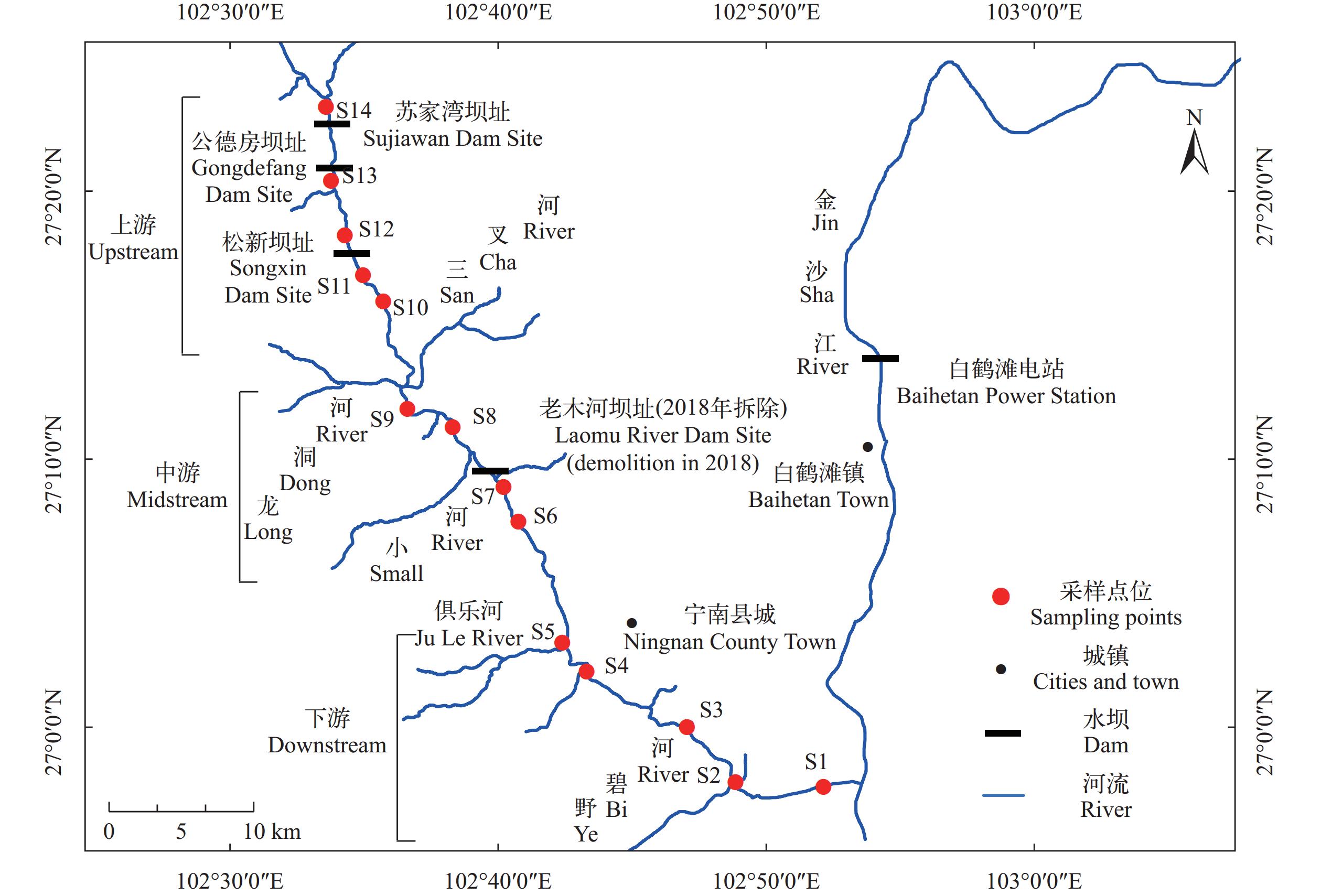
 下载:
下载:
